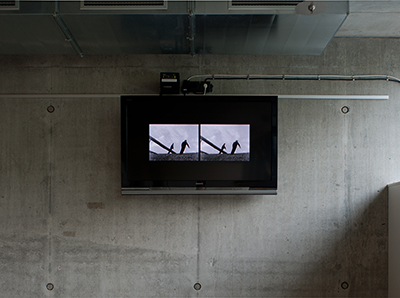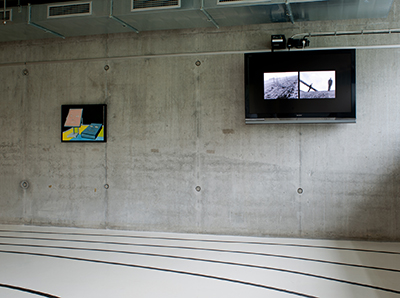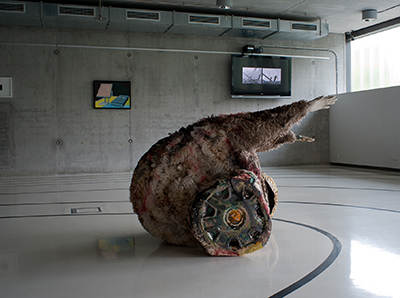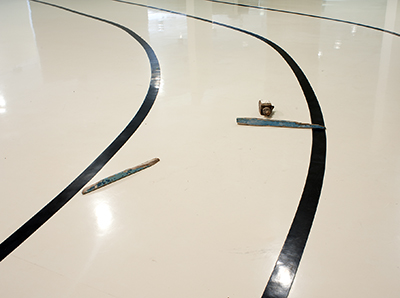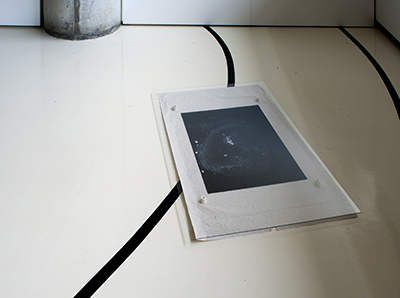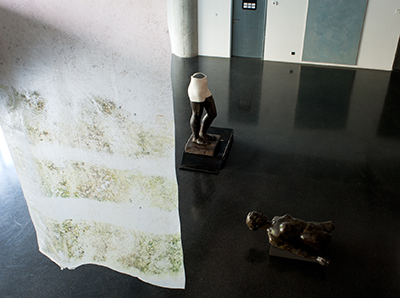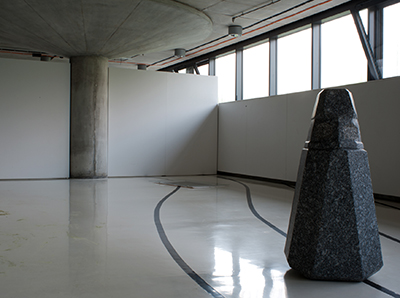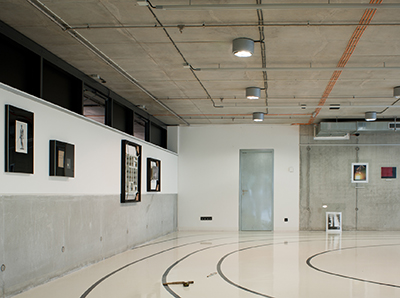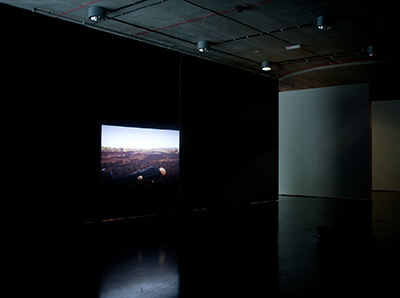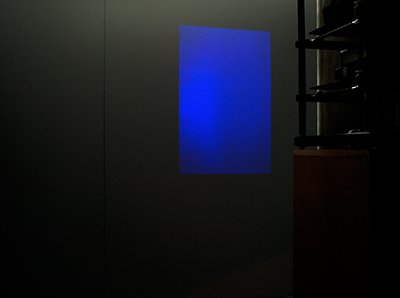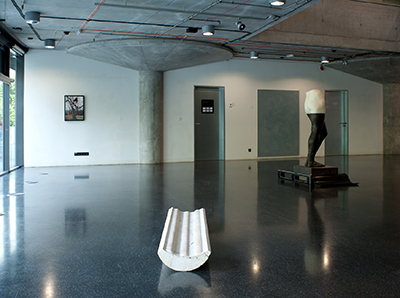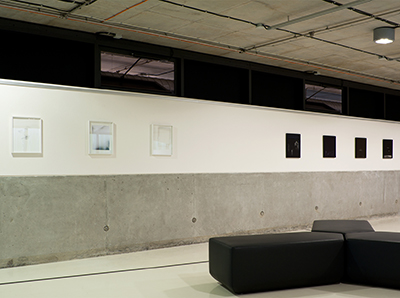Ephemeral Self – Finite Projectionscurated by Robert Gruber
Gallery NTK - Czech National Library of Technology, PragueAn idea that takes on form, whether it is worked out materially, structured in a rhetorical sense or formulated as a conceptual definition, goes through several different processes. The idea is not clear, but it is always flexible and fragile. A concept of mobility. It moves at the margin of what is comprehensible, always at risk of slipping away and crossing the boundary, beyond which we are not able to see – which as “the vanishing” releases us from any notion of its texture. For the idea is also an attempt at the thing we know nothing of, and of which we cannot have knowledge.
If the idea vanishes, we say that we have lost it. Just as we say: “I in the world”. Note that it – the idea – means I. It is not really that the idea is at risk of slipping away, but rather that I am the one who tries to grasp it; who tries to grasp himself, or herself; who is attempting the trial of the self. For the idea appears at the vague moment of a nevertheless specific, determinable relationship –my relationship – with something I want to obtain from myself. It is and demonstrates my relationship; which is peculiar to me. And in this conformity, which we call idea, I appear myself and I am significant. Admittedly, I do not appear thematically in the theoretical field of whatever I am thinking about, and yet I am the one who is thinking about something and, consequently, basically predetermine a significant adherent structure. This may also well be active, potentially moveable, but cannot be accessed directly – I do not bring it into my consciousness but rather, on the contrary, it makes me conscious. It is vague. And making an idea comprehensible is still a gamble with the original – to create it without simultaneously distorting it and to mask it or to lose it completely; performing the trick which would consist in setting boundaries without exclusion – making visible and yet retaining mobility. A state of uncertainty, which, like a balancing act, can be maintained without effort, concentration and self-understanding – and even that only for a certain stretch of time. To do the splits, after all, is to point in two directions without using a leg to stand on.
This idea cannot be pinned down – neither materially, nor rhetorically, nor conceptually. Its phenotype is from the realm of myth. It is process-driven, pre-definition, directional and yet without any recognisable, stationary end-point. Perhaps it will lose itself, I myself and I it again. In this context it can be described as movement. Movement is action. An action that itself has to be evidenced – not without effort. Every movement requires effort. In the sense of a change in direction, a shift from one point to another. “So that we can move on” – as is said in everyday speech. A movement or action presents a direction – it describes a vector determined by an outcome – and yet not an unconditional ending. The end-point is not foreseeable – one does not know how far one will move, in this direction or that and how things will then go one, could then go on. This means: unless one dares to undertake the shift in direction with an effort, the presumed advance and what happens after that are mere speculation. In this sense, “losing one’s way” is a phenotype of idea-formation or idea-formulation. Whatever goes ahead can lose its way. Every act of daring implies a risk.And how is this movement related to the form that contains it? Works of art are normally not suddenly there, fully thought through, and therefore mere realisations of a plan. In the movement and action only can conditions be described relating to a process of shaping, which is stationary and temporal. Conditions of form and projection. But these conditions last longer than the “finished work”. In them, the direction of a free, indeterminate formulation process is prejudged. It underlies the work, is contained within it and can be projected; in other words reaching out beyond material, spatial and temporal circumstances. In this way it returns to the realm of myth, from where it came, and only in this way becomes or can become material with significance – in rhetoric, material, definition, ...
The work is a representative relationship – more than a representative. It determines the stylistics (a significance within rhetoric) and comprehensible form of a process that is not comprehensible in itself – which remains pure phenomenon and thus however still projectable. Material itself is not projectable. In the work is the projection of the ephemeral self. Of the self trial.
What remains is the form – that much is clear – but still more: the projection of the unattainable, the unfixable, its attempt at a measure of conditions that is visible. The work is visible. For it satisfies the sense, the experience of a concurrence of an idea and its visibility situated in the work. In the work the projection becomes a seen synonym for the ephemeral itself. Processual clarity. The materials and materiality may affect equally the product and the follower of the ephemerality of the self. In the material there is essentially nothing participating in a structuring that experiments on itself that would be clear in a self searching for itself. It has to be supplied to it so that it can be taken away again – in the sense of formulation, processing and elaboration. Only then is it fundamental and only then does it precede (it, the material).
The material undergoes structuring while it is formed and informed. In this way it becomes itself the object of the projection. Where that begins, the material appears as part of the idea and on balance as one tool among others that give the movement its direction and drive it forward. Action/performance.
These “tools” are immaterial decisions, tangible/material and handicraft. It all develops along the proportionality between form and projection. And only this measure is decision-making for the movement, the direction of the action. In relation to the development of the work, the tools become qualities of the experiment.
The full development of a pre-definition, pre-rhetoric, pre-plausibility, … (emotional) field requires a conception of the tools. The fact that these tools are often taken from specific genres does not mean that they prescribe them. Tradition. Technology is applied science; it provides solutions or approaches. Models. The technology comes in a way before the genre that is “its” most useful (altruistic) revision. One kind of technology opens up a number of applications. The way one makes the knowledge that is in the technology effective – and with what intention – that is what matters. That presumes that one creates the experiences that are relevant now and which do not have to be those made previously. Certain tools for certain tasks. The technology concept, no less than that of the medium, includes applications. Media (and also technologies) operate in various communication applications and experiments. Apart from that, the concept makes little sense. What matters is the nature of the application, if an artistic use of a medium is to be distinguished from a non-artistic one? How does one come to applied myths? To a concurrence? *
Quite possibly, one myth cannot be assigned a place among others. The quality of a myth, of an emotional field for example, which is or has been developed is located not only in the conditions to be inquired into internally – at best one person has access to these in each case – but also in the tools that are used. Ideas are not usually exoteric experiments; they cannot be critically ranked. Critical ranking, an aspect of (art) history in the sense of communicability (of art), is itself a political myth. One that fails to comprehend this subject-matter. One formulation is granted plausibility as the individual search for the altruistically possible. (Fixation.) The work is more an intrinsically fixed proportionality than a duty to the surroundings. (Relationism.)An idea can be comprehensible for itself and others only in the visibility of the form. One must first “have” its form, in the sense of apprehending it, if one is to know what can be “expected” of it. Wherever a thought (a linguistic form or an early phase of orientation) exists, an idea can be “accommodated”. Provided one views the thought as something that is a significant phenomenon heuristically adjusted to the idea. The thought is then like a lodging. It can be visited or infested by more than one and from more than one direction and fetched home. In this sense we never “know” explicitly what art “is” but rather what we “have” from it. “Having” is no less necessary than its phenomenal “being”.
If they could always be categorised – these pre-definition, pre-rhetoric, pre-plausibility myths – there would rarely be a work that bridges the split between self-understanding and visibility that is inherent in art. Making the direct in itself immediately present as the indirect as if. Now, however, there is in art no less definition than myth. To put it cautiously. Technique in art as craft means mastering necessary tools – on the basis of their already widespread applications – or inventing them.
Producing a work of art does not require a special application of media, but rather the technique and application of tools is more specific, more secret, individual and personal. An idea demands a method for its representation. The method of the idea is its technique.
An idea does not simply become something, nor does something become something else. It is not simply there so that something has to become of it and would have no state it could return to if the process of becoming were to be unsuccessful. In it there is no pool of material, no materiality that simply exists and of which one can make use or on which one can try oneself out. Nothing to which one could apply or on which one could sharpen a thought, nothing to which reason has unlimited access at any time or with which a thought could refresh itself, on which one could rest or with whose aid one could grow – from time to time. It doesn’t exist, this materiality – one has to make it.
Every idea takes shape differently through perception, is brought into form differently; formulated. Shapes become experiences. Craft, technique as a concept for all applications of tools, decisions and materiality is, in relation to the work, the method – its method. Tools and applications are adapted to each other; they are, as the conception for developing a mythical field, an activity. “Method, a way for perception to achieve the object of inner possession – even if it is by means of generation in consciousness – is for truth representation if its self and therefore provided with it as form.” So writes Walter Benjamin in his preface to a critique of knowledge ** and he goes on: “This form does not take possession of a context in consciousness, as the methodology of perception does, but of a state of being.” The work is indeed a truth taken from the representation of an idea. The work is the being of the idea or indeed its projection; the context of idea and form.
Ephemeral Self – finite projections Artworks, representative set pieces of artistic work, carry out a self-owned occupation with what is identified by them through their and in their presence as the “impossible self”. Such occupations are experiments and final projections of a self whose existence remains volatile and vague. This can only be understood as linked – and consistent in the sense of the processual visibility as form – in the experiment. The experiment is a sketch of something that ends whatever begins in the formally existing work and yet can never be finally concluded. For the work in its sense, i.e. adjusted to its senses, is a projection of the impossible self. Transient but stable and in form in the actual realisation of the self as a kind of state. The in itself is the state of the same occupation with the incomprehensible self. The formal survival of these projections ends, however, in the eye of the beholder – temporarily and just locally embedded in the context of the exhibition. Finite projections.The works shown here are a compilation and overview of this connection, formal diversity of self-experiments; total performance or pure presence, which, even more than the form of individual artworks, is its body. The constantly recurring performance appears as the form of a finite projection; for works are relations between projection and clarity. The impossible experiment of a self in a stationary state. As self-experiment personal.
The state of the representation is the as-if; here it is the in-itself.
(R. Gruber)Notes:
* “Illusions, wishes and dreams, the fantasy of values, .. in short: myths are the basis of politicisations. Politicisation as the risky application of existing myths that may well be really new (historical codification), mystification, polarisation, the use of clichés (i.e. kitsch) in a significant state of knowledge (environment). In this, too, is the risk of application. It is not a matter of applied science (like technology) but of establishing a position – of the rhetoric of a theory whose truth content (a theory can be false or accurate) is of no significance in the fabric of construction.”
What happens if a myth is constructed as an institution? As a transition from idea to form? A myth requires space. An openness. Some myths are institutionalised, others occult.
“In every idea, in the process of institutionalisation, including establishment, that provides a open space, no matter how well concealed it might be (…) this mixture of theory and esotericism serves the free (individual) search for the actual (altruistically possible) meaning. Ghosts and vampires haunt the space. Movement in the space becomes uncanny because of their presence. The uncanny quality is the phenotype of myth creation. A myth is neither true nor false – false as a political tale can be (…) – as form. The institution exhausts itself as a transition from idea to form.” Myth has become form in art – which itself is Iittle more than a recognition of this process (active movement) within an agreement on a concept (of) “art” in a significant space, the „art space“.
/ from: Robert Gruber, “Dienstag Abend, ehem. Von Ludwig Kittinger und Fernando Mesquito”, ein Text für Ludwig Kittinger, in: “Vier Jahre Ve.Sch ungefähr…”, November 2012, Publishers: Ludwig Kittinger, Martin Vesely, Franz Zar, Ve.Sch, Wien, 2012
** Walter Benjamin, Ursprung des deutschen Trauerspiels/ Erkenntniskritische Vorrede, 1925 /zitiert nach: suhrkamp taschenbuch wissenschaft 225, S.11, Frankfurt am Main, 1978. [The Origins of German Tragedy.]
Text: Robert Gruber, 2013, Translation English: Nelson Wattie, 2013
ephemeral self - finite projections, edited by: Robert Gruber, Alexandr Puskin and Milan Mikulastik, Galerie NTK
ISBN: 978-80-86504-29-2, Vienna/Prague, 2013

